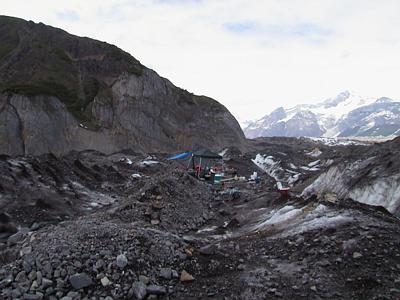
|
|
2 July, 2000
July 2, 2000
We are in the field, at our respective study sites, and working. The most
important thing on everyone's mind was the status of the lake surface
elevation. PI Joe Walder (U.S. Geological Survey scientist from the Cascade
Volcano Observatory in Vancouver, Washington) radioed the rest of us with
some lake level information. Yesterday he let us know that the lake was 10
feet below the high water mark of last year. Last year the lake was filling
at about 2 feet per day, so at that pace the surface of the lake should be at
last year's maximum elevation in 5 days. This means that the filling of the
lake is about a week ahead of last year. But this was yesterday's
information…………..
This morning, PSU grad student (and lake team member) Michelle Cunico radioed
us and told us that the lake had risen 7 inches in 4 hours. This means that
the lake is rising at a rate of nearly 4 feet per day. At this rate the high
water mark that was measured from last year will be reached in 2 days.
Unfortunately this information tells us little about when the lake will drain
this year. Kennicott outburst flood dates can vary widely from year to year.
It is still not known what triggers the flood. Yet, we all can't help but
to compare to last year's conditions as a way to anticipate the timing of
this year's flood. We, the drilling team, were placed much closer to the
lake on the ice dam than last year. We were expecting to drill here for
about 8 days, and then get lifted to a new location further back on the
glacier. We were not expecting to be drilling this close to the lake when
the drain began. As the lake fills with water, it "floats" the adjacent
glacier margin. This glacier margin is the ice dam. We are in an area that
appears to have floated and subsequently collapsed last year. Hopefully the
lake will not drain under the same lake level conditions as last year.
Getting out of this location could be dicey with the number of crevasses that
will likely start opening here when the flood starts.
Drilling began today. St. Olaf undergraduate student Andrew Malm worked his
magic with the ice radar, and let us know straight away that the depth to the
bottom of the glacier was about 200 meters. An approximate 60-meter deep
hole has been made in about 3 hours. The drilling is accomplished by
extruding hot water from the end of a narrow, metal tube that melts a
borehole in the glacier. If you want to read more about how glacier drilling
works, then see my journal entry from June 27. The first hole will likely be
completed by tomorrow. Then it will be time to employ the borehole video
camera to look at borehole conditions..

Drilling and camping gear strewn on the glacier after yesterday's helicopter sling load delivery. The rocky debris provides a thin cover for the underlying glacier ice. Hidden Creek Lake is a few hundred meters beyond this photo. This portion of the glacier is expected to float on Hidden Creek Lake as it continues to rise.

The main camp tent, pitched near our first drill site, nestled between seracs and crevasses on the ice dam. This is a very active part of the glacier, as evidenced by the seracs (small ridges) and crevasses (not seen, but not far off to the left and right of the photo).

Contact the TEA in the field at
.
If you cannot connect through your browser, copy the
TEA's e-mail address in the "To:" line of
your favorite e-mail package.
|
